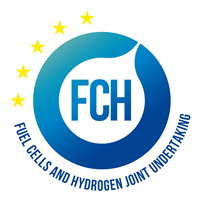EU - FCH2 - JU Funding
Research in electrolysis for cost effective hydrogen production
Electrolysers, Water electrolysis, Hydrogen, High Temperature Solid Oxide Electrolysis Cells and Stacks, H2O Electrolysis, H2O & CO2 Co-electrolysis
Hydrogen can be produced and become a solution for storing electricity, which can be further used as a carbon-free fuel by the oil and gas industry.
Electrolysers are electrochemical devices which convert electricity into chemical energy of fuels such as H2 or syngas (CO + H2). A Solid Oxide Electrolytic Cell (SOEC) is a Solid Oxide Fuel Cell (SOFC) that runs in reverse mode to achieve the electrolysis of steam (H2O) or the co-electrolysis of steam and carbon dioxide (H2O + CO2), at high temperatures.
Indicatively, high temperature Solid Oxide Electrolysis can be implemented in a combined SOEC-SOFC system with a broad applications range. The conversion of steam and electrical energy into H2 and O2 is achieved electrochemically by using an electrolyser.
High temperature co-electrolysis of H2O and CO2 has the advantages of (i) very efficient use of electricity and heat (near 100% electricity-to-syngas efficiency), (ii) high reaction rates and (iii) direct production of syngas with proper composition for use in conventional Fischer-Tropsch catalytic fuel synthesis reactors.
The aim of this research is to understand the degradation and lifetime fundamentals of the high (700–900 oC) temperature H2O electrolysis and to a certain extent for the H2O/CO2 co-electrolysis. The project is focusing on both of the Solid Oxide Electrolysis Cell (SOEC) electrodes.
 |
 |
This project has received funding from the Fuel Cells and Hydrogen 2 Joint Undertaking under grant agreement No 671481. This Joint Undertaking receives support from the European Union’s Horizon 2020 research and innovation programme. |